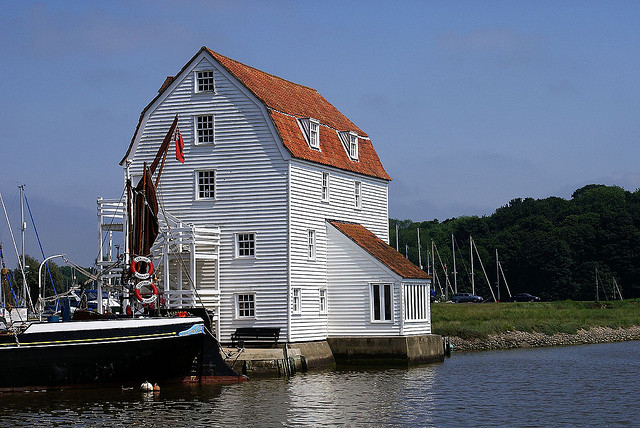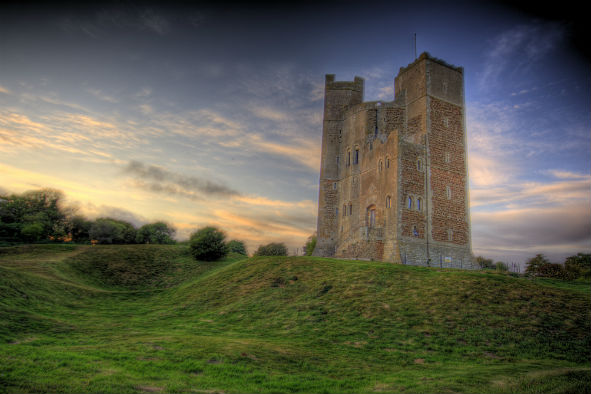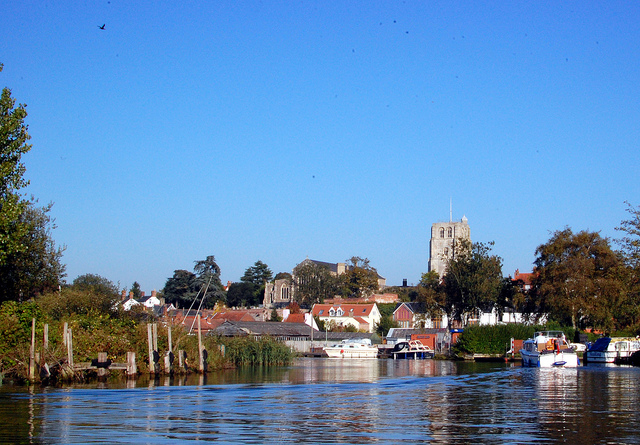As summer winds to a close there are still a great number of ways to get out and about and make the most of the British countryside. Suffolk has long been a cycling hub due to its flat terrain and stunning rural scenery and it’s perfectly possible to see a lot of it within a few leisurely days.

Orford Castle (Photo: John Mitchell via Flickr)
Bury St. Edmunds to Lowestoft is just one suggestion, but it’s a route which will tale you through quaint English towns and villages, expansive natural countryside, forests and fields. Let TravelMag take you on a tour which skims the unique Sunshine Coast, showing off the best of the region’s sights.
Start and finish points Bury and Lowestoft are well-connected, thriving towns and easy to pick up a train from London or beyond. The trails are easygoing enough to suit any keen leisurely cyclist, couples, groups or solo adventurers. This suggestion makes a total journey of 100 miles spread over three days.
Day 1: Bury St. Edmunds to Woodbridge, via Needham Market (36.4 miles, 2 hours 42 minutes)
Take national cycle route number 51 from Bury St. Edmund’s towards Ipswich. The road goes through Thurston, Drinkstone, Woolpit, Borley Green, Harleston, Onehouse and Stowmarket, which are all nice enough places for a pit-stop, but it’s worth continuing just past here for lunch in Needham Market.
Now nothing more than a sleepy market town, Needham Market has a rich history. The black plague swept the town in 1663 and the town locked itself in to prevent the disease spreading. It’s unsurprising perhaps that two thirds of its people died as a result, but not many people know that the town was also home to Joseph Priestley, an 18th century theologian, chemist and all-round genius who discovered oxygen.
Alder Carr Farm is located five minutes east of the high street, down Hawks Mill Street and across the river Gipping. Here you will find some boutique shops and an excellent selection of cakes and sandwiches in the Barn Café. Stock up on snacks from the farm shop and continue your journey away from Needham and north of the A14 dual carriageway via the underpass. Cycle on down the wide, quiet roads of Claydon, Akenham Westerfield, Tuddenham St. Martin, Little Bealings and finally Woodbridge.
Woodbridge is a pretty town which sits on the river Deben, making it a Mecca for sailing enthusiasts. Be sure to visit Tide Mill on the quayside – it’s one of the oldest working tide mills in the country and the building also opens as a museum, demonstrating the history of the area. Woodbridge goes mad for seafood, and the Tide Mill Cafe does a fantastic cray fish sandwich at lunchtime. Woodbridge high street has a great selection of antique, vintage and second-hand shops, all set among the quintessentially english architecture of medieval timber-framed houses which gives the town its charm.

Woodbridge Mill (Photo: Martin Pettitt via Flickr)
You will be spoilt for choice in terms of where to stay the night, but Hill House Hall has been rated one of the best hotels in the world and sits conveniently in the centre of the town with a great view of the church. The B+B links up with the medieval Wealden Hall which dates back to the 14th century. Rooms start from £65 per night and you will be very well looked after by the host family. Alternatively, Quay House has three double rooms on offer and is just as beautiful a setting with its 17th century features and original artworks. Most importantly, the breakfast is excellent and the house is situated right next to the Anchor pub – a local favourite that serves hearty, traditional pub food with good vegetarian options.
Day 2: Woodbridge to Aldeburgh, via Hollesley, Orford and Snape. (31.5 miles, 2 hours 41 minutes; B1083, cycle route 41)
Alternative route: after Hollesley, turn right at Capel St. Andrew junction and take the ferry across the Butley river.
The next leg of the journey is not as far, but it is quite fiddly. Head east out of Woodbridge through Melton, past Woodbridge Golf Club and down and around historic Sutton Hoo, an Anglo Saxon burial ground which dates back to the 6th and 7th centuries. If history is your bag, Woodbridge is a great base to explore the site from.
Take the B1083 down through Sutton and onto Woodbridge road until you reach Alderton. The Swann Inn is just a few metres down The Street [sic] and makes a good place to stop for a drink. Turn north up Hollesley road until the t-junction. Then turn right into Alderton road and through Hollesley, making up a scenic little detour which allows you to experience the real Suffolk countryside in its raw, desolate form. Follow the road all the way up to Chillesford, turn right back onto the B1084 until it meets Orford road – and this might just give you a hint at the next stop point.

Orford Castle (Photo: John Mitchel via Flickr)
Orford has a fantastic 12th century castle with scenery and activities to entertain the minds of any age group. Alternatively, take a boat trip down the Alde river along the large shipping spit which separates Orford from the sea and keeps its waters still and calm. The town is also known for its smoked salmon, ham hocks and Butley oysters – a fantastic rest stop for foodies. Try the Butley Orford Oysterage on Market Hill for unique local dining. Lunch is served between 12pm and 2.15pm so you’ll have to get in quickly. It’s worth it for the fresh seasonal fish caught just metres from your table. The owners are keen purveyors of sustainable fishing and have many a story to share with inquisitive visitors.
Out of Orford, take National Cycle Route 41 up past Sudbourne and cross the river at Snape Maltings. Park up and take a walk around through the 2,000 year old village of Snape – home to independent shops, restaurants, wildlife and birdwatching hubs. Of course the area is most famous for the Snape Maltings Concert Hall, where composer Benjamin Britten lived and worked.
The iconic Maltings are situated in an official Area of Outstanding Natural Beauty, making the area a popular visitors attraction for birdwatchers, artists and ramblers alike. Be sure to see the Maltings Gallery before stopping a classic afternoon tea at the Granary Tea Shop, or catch a matinee performance in the stunning Victorian concert hall.
In late September, Snape Maltings also plays host to the annual Aldeburgh Food Festival, when food-lovers and critics flock to try fine local produce or watch demonstrations from some of the country’s leading chefs.
Now tear yourself away and prepare for the final leg up to Aldeburgh. Priory road links up with Aldeburgh road and soon you will see the sea. Aldeburgh is a very fashionable town with stunning sea views and a world famous fish and chip shop (yes, it really is that good!). Some evenings locals will queue all through the town to get their haddock or plaice, but you can always opt out and wait to be seated upstairs in the Upper Deck Fish and Chip Diner.
Those wanting a touch more decadence should visit the The Lighthouse, an award winning restaurant which offers seasonal dining even for those who don’t eat fish. There are a wide range of pubs with a buzzing atmosphere along the beach, including the Mill Inn on Market Cross, which has comfortable accommodation above it. The Old Library is another great option – just a few metres from the beach, this accommodation has kitchen and living facilities, including a big open fireplace for a cosy winter night’s stay.
Day 3: Aldeburgh to Lowestoft, via Dunwich and Beccles (39.2 miles, 3 hours 16 minutes)
Heading back out of the town onto National Cycle Route 42, cycle past Leiston and up to Dunwich, a quiet, understated seaside town which was once the Anglo Saxon capital of the Kingdom of East Angles. The unspoilt Dunwich Heath and high beach mounds are perfect for a bracing stroll and will lead you to Flora Tearooms, a friendly local cafe perfect for lunch or a quick coffee break.
Back onto route 42 – you are now following the official Suffolk Coast Cycle Route. Cycle in and around Halesworth to finish in Beccles for the afternoon. The town is a thriving cultural hub and a great base for exploring the Broads National Park.

Beccles from the water (Photo: Dave Sandford via Flickr)
Alternative Route: If ale is your tipple, make a detour up to Southwold where the Adnams brewery runs tours around its thriving distillery. Of course, you’ll find Adnams Broadside and the famous Adnams Southwold Bitter in most local pubs around the region. Just remember that you’ve got to be able to get back on your bike…
Back over in Beccles, a popular landmark to see is the Bell Tower. Built in 1515, the tower stands at 97ft tall and visitors can climb the 122 steps to the top for stunning views across the countryside. If energy is waning however, spend an hour or two in The Upstairs Gallery, a hidden gem which hosts a range of paintings, antique collections and sculpture, much of which is available to buy. The gallery hosts 89 exhibitors every month and 100% of art sales go directly to the artist.
From Beccles, it’s just under an hour’s ride to Lowestoft, the most easterly point in the UK, where a good night’s sleep can be caught up on at any one of hundreds of hotels or B&Bs. Stroll along wide, sandy beaches or visit the Lowestoft Maritime Museum, for a fascinating insight into Lowestoft’s history as a centre for the fishing industry. Congratulate yourself for making it to the end of your 100 mile journey and head onwards by train to London, Norwich or Cambridge.